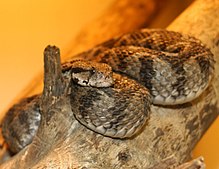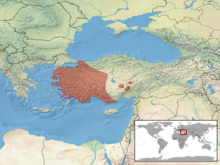Montivipera xanthina
| Montivipera xanthina | |
|---|---|

| |
| Scientific classification | |
| Domain: | Eukaryota |
| Kingdom: | Animalia |
| Phylum: | Chordata |
| Class: | Reptilia |
| Order: | Squamata |
| Suborder: | Serpentes |
| Family: | Viperidae |
| Genus: | Montivipera |
| Species: | M. xanthina
|
| Binomial name | |
| Montivipera xanthina (Gray, 1849)
| |

| |
Synonyms[2]
| |
| |
Montivipera xanthina, known as the rock viper, coastal viper, Ottoman viper,[4] and by other common names, is a viper species found in northeastern Greece and Turkey, as well as certain islands in the Aegean Sea. Like all other vipers, it is venomous. No subspecies are currently recognized.[5]
Description
It usually grows to a total length (body + tail) of 70–95 cm (27.6-37.4 in), but reaches a maximum total length of 130 cm (51.2 in) on certain Greek islands in the Aegean Sea.[4]
Habitat
Montivipera xanthina can be found living in humid areas.[7] It favors rocky and "well-vegetated" areas for its habitat.[7]
Prey
The diet of M. xanthina is thought to consist of rodents and other small mammals and native birds.[7] It may prey on lizards, as well.[7]
Common names
Rock viper, coastal viper, Ottoman viper, Turkish viper, Near East viper,[4] mountain viper.[8]
Geographic range
Extreme northeastern
The
Conservation status
This species is classified as least concern according to the
Taxonomy
According to Nilson, Andrén and Flärdh (1990),
Venom
There is not much information and data about the venom composition, activity, and lethality of this specific species. However, similar to other species within the genus Montivipera and the related Vipera genus, it has mainly cytotoxic, haemotoxic, and other minor components to its venom. Although it injects only small amounts of venom in a bite, the venom of this species is highly potent and has been known to have caused fatalities in adult humans. This can be more common in young children or older individuals that get a case of severe envenomation (especially if fangs inject venom directly into a vein, for instance).
According to Batzri-Izraeli et al, 1982, the LD50 value via intravenous injection (IV) was 0.25 mg/kg.[10] Similarly, Iranian herpetologist Mahmoud Latifi found the lethality (LD50) of the crude venom from the species Montivipera xanthina to be 0.42 mg/kg in a 1984 study,[11] and 0.35 mg/kg in a 1985 study, which Latifi conducted for the Department of the Environment in Iran (was translated to English in 1991). For most adult male humans of 70 kg (150 lb), the estimated lethal dose is thought to be between 40–50 mg.[12] In his 1984 study, Latifi found the average venom yield to be 10 mg (dry weight of milked venom). This average was attained from the milking of 4,446 specimens of M. xanthina. The maximum yield was 18 mg (dry weight of milked venom) in the same study.[11]
Further reading
- ISBN 0-00-219318-3. (Vipera xanthina, p. 223 + Plate 40 + Map 126.)
- Gray JE. 1849. Catalogue of the Specimens of Snakes in the Collection of the British Museum. London: Trustees of the British Museum. (Edward Newman, printer.) xv + 125 pp. (Daboia Xanthina, p. 24.)
- Nilson G, Andrén C. 1986. The mountain vipers of the Middle East: The Vipera xanthina complex. Bonner Zoologische Monographien 20: 1-90.
- Nilson G, Andrén C, and Flärdh B. 1990. Vipera albizona a new mountain viper from central Turkey, with comments on the isolating effects of the Anatolian "diagonal." Amphibia-Reptilia 11: 285-294.
- Schwarz E. 1936. Untersuchungen über Systematik und Verbreitung der europäischen und mediterranen Ottern. Behringwerke-Mitteilungen 7: 159-262.
References
- ^ . Retrieved 9 January 2018.
- ^ ISBN 1-893777-01-4(volume).
- ^ The Reptile Database. www.reptile-database.org
- ^ ISBN 0-89464-877-2.
- ^ "Montivipera xanthina". www.itis.gov. Retrieved 2022-02-27.
- ^ "1000 Pictures - Free Desktop Wallpaper".
- ^ ISBN 1-84773-086-8. (Vipera xanthina, p. 58.)
- ISBN 0-7137-1704-1.
- ^ Convention on the Conservation of European Wildlife and Natural Habitats, Appendix II at Council of Europe. Accessed 9 October 2006.
- PMID 7179294. Retrieved 24 September 2022.
- ^ PMID 6474490.
- ISBN 978-0-916984-22-9.
External links
- Montivipera xanthina at the Reptarium.cz Reptile Database. Accessed 18 January 2010.
- Montivipera xanthina at Amphibians and Reptiles of Europe. Accessed 18 January 2010.

